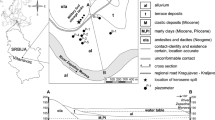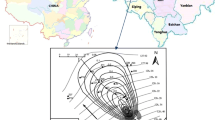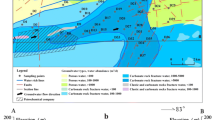Abstract
The role of natural attenuation processes in groundwater contamination by petroleum hydrocarbons is of intense scientific and practical interest. This study provides insight into the biodegradation effects in groundwater at a site contaminated by kerosene (jet fuel) in 1993 (Vitanovac, Serbia). Total petroleum hydrocarbons (TPH), hydrochemical indicators (O2, NO3−, Mn, Fe, SO42−, HCO3−), δ13C of dissolved inorganic carbon (DIC), and other parameters were measured to demonstrate biodegradation effects in groundwater at the contaminated site. Due to different biodegradation mechanisms, the zone of the lowest concentrations of electron acceptors and the zone of the highest concentrations of metabolic products of biodegradation overlap. Based on the analysis of redox-sensitive compounds in groundwater samples, redox processes ranged from strictly anoxic (methanogenesis) to oxic (oxygen reduction) within a short distance. The dependence of groundwater redox conditions on the distance from the source of contamination was observed. δ13C values of DIC ranged from − 15.83 to − 2.75‰, and the most positive values correspond to the zone under anaerobic and methanogenic conditions. Overall, results obtained provide clear evidence on the effects of natural attenuation processes—the activity of biodegradation mechanisms in field conditions.







Similar content being viewed by others
References
Alvarez, J. P., & Illman, A. W. (2006). Bioremediation and natural attenuation: process fundamentals and mathematical models. New York: Willey.
Amin, I. E., & Jacobs, A. M. (2013). A study of the contaminated banks of the Mahoning River, Northeastern Ohio, USA: characterization of the contaminated bank sediments and river water–groundwater interactions. Environmental Earth Sciences, 70, 3237–3244.
APHA. (1995). Standard methods for the examination of water and wastewater. Washington, DC: American Public Health Association.
Baedecker, M. J., Cozzarelli, I. M., Eganhouse, R. P., Siegel, D. I., & Bennett, P. C. (1993). Crude oil in a shallow sand and gravel aquifer-III. Biogeochemical reactions and mass balance modeling in anoxic groundwater. Applied Geochemistry, 8, 569–586.
Beškoski, V. P., Gojgić-Cvijović, G., Milić, J., Ilić, M., Miletić, S., Šolević, T., & Vrvić, M. M. (2011). Ex situ bioremediation of a soil contaminated by mazut (heavy residual fuel oil)—a field experiment. Chemosphere, 83, 34–40.
Bolliger, C., Höhener, P., Hunkeler, D., Häberli, K., & Zeyer, J. (1999). Intrinsic bioremediation of a petroleum hydrocarbon-contaminated aquifer and assessment of mineralization based on stable carbon isotopes. Biodegradation, 10, 201–217.
Bossert, I. D., Shor, L. M., & Kosson, D. S. (2002). Methods for measuring hydrocarbon biodegradation in soils. Washington, DC: ASM Press.
Bradley, P. M. (2003). History and ecology of chloroethene biodegradation: a review. Bioremediation Journal, 7(2), 81–109.
Chapelle, F. H. (2000). The significance of microbial processes in hydrogeology and geochemistry. Hydrogeology Journal, 8(1), 41–46.
Das, N., & Chandran, P. (2011). Microbial degradation of petroleum hydrocarbon contaminants: an overview. Biotechnology Research International. https://doi.org/10.4061/2011/941810.
Doherty, V. F., & Otitoloju, A. A. (2013). Monitoring of soil and groundwater contamination following a pipeline explosion and petroleum product spillage in Ijegun, Lagos Nigeria. Environmental Monitoring and Assessment, 185, 4159–4170.
Hamed, M. M. (2005). Screening level modeling of long-term impact of petroleum hydrocarbon contamination on fresh groundwater lenses in the Arabian Gulf region. Environmental Modeling & Assessment, 9(4), 253–264.
ISO. (2009a). Determination of alkalinity (EN ISO 9963-1:07). Belgrade: Institute for Standardization of Serbia.
ISO. (2009b). Determination of hydrocarbon oil index, method using solvent extraction and gas chromatography (EN ISO 9377-:2:09). Belgrade: Institute for Standardization of Serbia.
Jurgens, B.C., McMahon, P.B., Chapelle, F.H., & Eberts, S.M. (2009). An Excel workbook for identifying redox processes in ground water: U.S. Geological Survey Open-File Report 2009–1004 8p. Available at http://pubs.usgs.gov/of/2009/1004/.
Kaćanski, A. (1995). Hydrogeological problems of the groundwater contamination in alluvial deposits of Zapadna Morava in Vitanovac (Kraljevo). Belgrade: Faculty of Mining and Geology [in Serbian].
Kelly, J., Thornton, I., & Simpson, P. R. (1996). Urban geochemistry: a study of the influence of anthropogenic activity on the heavy metal content of soils in traditionally industrial and nonindustrial areas of Britain. Applied Geochemistry, 11, 363–370.
Landmeyer, J. E., Vroblesky, D. A., & Chapelle, F. H. (1996). Stable carbon isotope evidence of biodegradation zonation in a shallow jet-fuel contaminated aquifer. Environmental Science & Technology, 30, 1120–1128.
Lang, F. S., Destain, J., Delvigne, F., Druart, P., Ongena, M., & Thonart, P. (2016). Characterization and evaluation of the potential of a diesel-degrading bacterial consortium isolated from fresh mangrove sediment. Water, Air, & Soil Pollution, 227, 58. https://doi.org/10.1007/s11270-016-2749-7.
Lawniczak, A. E., Zbierska, J., Nowak, B., Achtenberg, K., Kowiak, A. G., & Kanas, K. (2016). Impact of agriculture and land use on nitrate contamination in groundwater and running waters in central-west Poland. Environmental Monitoring and Assessment, 188, 172. https://doi.org/10.1007/s10661-016-5167-9.
Liu, H., Zhang, L., Deng, H., Liu, N., & Cuizhu, L. (2011). Microbiological characteristics of multi-media PRB reactor in the bioremediation of groundwater contaminated by petroleum hydrocarbons. Environmental Monitoring and Assessment, 181, 43–49.
Lollar, B. S., Slater, G. F., & Sleep, B. (2001). Stable carbon isotope evidence for intrinsic bioremediation of tetrachloroethene and trichloroethene at area 6, Dover Air Force Base. Environmental Science & Technology, 352, 261–269.
Lu, Q., Zhu, R. L., Yang, J., Li, H., Liu, Y., Lu, S. G., Luo, Q. S., & Lin, K. F. (2015). Natural attenuation model and biodegradation for 1,1,1-trichloroethane contaminant in shallow groundwater. Frontiers in Microbiology, 6, 839. https://doi.org/10.3389/fmicb.2015.00839.
Lv, H., Wang, Y., Su, X., & Zhang, Y. (2015). Combined 14C and d13C analysis of petroleum biodegradation in a shallow contaminated aquifer. Environmental Earth Sciences, 74, 431–438.
Mackay, D. M., & Cherry, J. A. (1989). Groundwater contamination: pump-and-treat remediation. Environmental Science & Technology, 23, 630–636.
Marić, N. (2016). Natural attenuation and enhanced bioremediation of groundwater contaminated by petroleum hydrocarbons. Ph.D. thesis. University of Belgrade, Faculty of Mining and Geology, pp. 1–181. [in Serbian].
Marić, N., & Nikić, Z. (2016). Potential of natural attenuation processes in environmental contamination by petroleum hydrocarbons. Proceedings of the 3 rd Conference of the World Association of Soil and Water Conservation. Belgrade: Faculty of Forestry, pp. 63–64.
Marić, N., Ilić, M., Miletić, S., Gojgić-Cvijović, G., Beškoski, V., Vrvić, M. M., & Papić, P. (2015). Enhanced in situ bioremediation of groundwater contaminated by petroleum hydrocarbons at the location of the Nitex textiles, Serbia. Environmental Earth Sciences, 74(6), 5211–5219.
Matić, I. (1994). Research activities on the monitoring of accidental groundwater contamination by kerosene in Vitanovac (Kraljevo). Belgrade: Faculty of Mining and Geology [in Serbian].
McMahon, P. B., & Chapelle, F. H. (2008). Redox processes and water quality of selected principal aquifer systems. Ground Water, 46(2), 259–271.
Mulligan, C. N., & Yong, R. N. (2004). Natural attenuation of contaminated soils. Environment International, 30(4), 587–601.
Nikić, Z., & Radonja, P. (2009). Modelling the influence of hydrogeological parameters on low flow in hilly and mountainous regions of Serbia. Hydrological Sciences Journal – Journal des Sciences Hydrologiques, 54(3), 484–496.
Revesz, K., Coplen, T. B., Baedecker, M. J., Glynn, P. D., & Hult, M. (1995). Methane production and consumption monitored by stable H and C isotope ratios at a crude oil spill site, Bemidji, Minnesota. Applied Geochemistry, 10, 505–516.
Scheutz, C., Durant, N. D., Hansen, M. H., & Bjerg, P. L. (2011). Natural and enhanced anaerobic degradation of 1,1,1-trichloroethane and its degradation products in the subsurface—a critical review. Water Resources, 45, 2701–2723.
SMEWW. (1995). Standard methods for examination of water and wastewater, titrimetric determination of dissolved CO 2 (4500-CO 2 С). Washington, DC: American Public Health Association/American Water Works Association/Water Environment Federation.
Spötl, C. (2005). A robust and fast method of sampling and analysis of δ13C of dissolved inorganic carbon in ground waters. Isotopes in Environmental and Health Studies, 41(3), 217–221.
Taniguchi, M., Uemura, T., & Jago-on, K. (2007). Combined effects of urbanization and global warming on subsurface temperature in four Asian cities. Vadose Zone Journal, 6, 591–596.
Topinkova, B., Nesetril, K., Datel, J., Nol, O., & Hosl, P. (2007). Geochemical heterogeneity and isotope geochemistry of natural attenuation processes in a gasoline-contaminated aquifer at the Hnevice site, Czech Republic. Hydrogeology Journal, 15(5), 961–976.
Travis, C. C., & Doty, C. B. (1990). Can contaminated aquifers at superfund sites be remediated? Environmental Science & Technology, 24, 1464–1466.
US EPA. (1999). Use of monitored natural attenuation at superfund, RCRA corrective action, and underground storage tank sites, OSWER directive 9200.4-17P. Washington, DC: U.S. Environmental Protection Agency, Office of Solid Waste and Emergency Response.
US EPA 200.7 Rev. 5. (1998). Determination of metals and trace elements in water and wastes by inductively coupled plasma-atomic emission spectrometry. Cincinnati: U.S. Environmental Protection Agency.
US EPA 300.1. (1997). Determination of inorganic anions in drinking water by ion chromatography. Cincinnati: U.S. Environmental Protection Agency.
US NRC. (1993). In situ bioremediation, when does it work? Washington, DC: National Academy Press.
US NRC. (1994). Alternatives for ground water cleanup. Washington, DC: National Academy Press.
Velinsky, D. J., Riedel, G. F., Ashley, J. T. F., & Cornwell, J. C. (2011). Historical contamination of the Anacostia River, Washington, D.C. Environmental Monitoring and Assessment, 183, 307–328.
Wiedemeier, T. H., Rifai, H. S., Newell, C. J., & Wilson, J. T. (1999). Natural attenuation of fuels and chlorinated solvents in the subsurface. New York: Willey.
Zhang, M., Geng, S., Ustin, S. L., & Tanji, K. K. (1997). Pesticide occurrence in groundwater in Tulare County, California. Environmental Monitoring and Assessment, 45(2), 101–127.
Funding
This study was supported by the Ministry of Education, Science and Technological Development of the Republic of Serbia under Grant No. III 43004 and Grant No. OI 176018.
Author information
Authors and Affiliations
Corresponding author
Ethics declarations
Conflict of interest
The authors declare that there is no conflict of interest.
Rights and permissions
About this article
Cite this article
Marić, N., Matić, I., Papić, P. et al. Natural attenuation of petroleum hydrocarbons—a study of biodegradation effects in groundwater (Vitanovac, Serbia). Environ Monit Assess 190, 89 (2018). https://doi.org/10.1007/s10661-018-6462-4
Received:
Accepted:
Published:
DOI: https://doi.org/10.1007/s10661-018-6462-4




